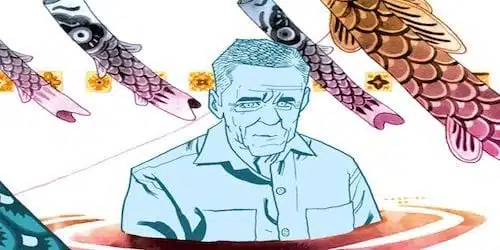
Sometimes I live in the country.
Sometimes I live in town.
Sometimes I have a great notion
To jump in, into the river and drown.
Irene, goodnight. Irene, goodnight.
Goodnight, Irene. Goodnight, Irene.
I’ll see you in my dreams.
— Leadbelly, “Goodnight Irene”
But I remember us riding in my brother’s car
Her body tan and wet down at the reservoir
At night on them banks I’d lie awake
And pull her close just to feel each breath she’d take.
Now those memories come back to haunt me.
They haunt me like a curse.
Is a dream a lie if it don’t come true
Or is it something worse
That sends me down to the river,
Though I know the river is dry.
That sends me down to the river tonight.
Down to the river,
My baby and I.
Oh, down to the river we ride.
— Bruce Springsteen, “The River”
Every so often in the comics medium, a unique story comes along that not only works in every conceivable way, from concept to script to artwork and beyond, but actually serves as a concrete example of the potential greatness of the medium, elevating the entire output of the field but also throwing down a gauntlet, daring others to do better. A Contract with God, American Splendor, Watchmen, Transmetropolitan, Bone, The Dark Knight Returns, The Sandman, Maus, Marvels, The Invisibles, and, most recently, Promethea, Y: The Last Man, All-Star Superman and A God Somewhere have been more than perfect examples of the form. They have, for all intents and purposes, changed the game forever in their own unique ways. A Contract with God and American Splendor showed the world that comics could be more than just capes and tights. Dark Knight Returns and Watchmen proved to cynics that superheroes could be both adult and socially relevant without abandoning their basic conceits. Bone showed that comics could still have an all-ages wonder and whimsy on par with Tolkein’s finest works, and All-Star Superman showed that that sense of awe could still be applied to superheroes without talking down to readers.
If there’s any justice in the world, in the years to come Fábio Moon and Gabriel Bá’s gamechanging Daytripper will join that list of beloved, respected comics tales. Sure, the unique structure of the series is innovative: the hero, frustrated obit writer Brás de Oliva Domingos, dies (frequently abruptly) at the end of each issue at various different ages, representing the “death” of a certain period of his life. But this compelling hook is one of the many reasons why Daytripper deserves to be considered the next Sandman or Maus.
Everyone remembers where they were the first time they caught a glimpse of the person who would eventually become their partner throughout life, the birth of their first child, the death of a parent, the loss of a close friend. Daytripper meditates on these moments but never becomes lost in them. Moon and Bá make us connect with Brás and his loved ones in a way similar to the readers’ friends and family. Like Alan Ball’s Six Feet Under, readers will walk away from each installment of Daytripper feeling like they just had a nice day out with a close friend, and that they had been relayed updates in the lives of mutual compatriots. From the word “go”, Moon and Bá have the readers hearts, minds and souls in their hands and do not let them go.
That’s not to say that Daytripper is emotionally manipulative; in fact, quite the opposite. More than just a profound meditation on death, it earns the emotional reaction it receives from its readers not by playing them like a well-tuned instrument but by immersing them into Brás’s life. His pain becomes the readers’. His joy is shared by the book’s fans. His loss is measured by the losses in the lives of his readership. Similar to Mark Romanek’s film version of Never Let Me Go, even as the main characters suffer tremendous losses in their personal lives and balance them with success in what they think they want most in life, the last few moments of the tale reveal the true essence of the work. In Never Let Me Go, it’s that, like Thomas Wolfe said, you can’t go home again. In Daytripper, it’s that you can go home again, but in light of, well, your life…why would you want to?
Rarely do comics — or any storytelling medium, for that matter — take on the profound themes infused into the very core of Daytripper with such ease as to make it look effortless. Mixed with the expert craftsmanship of two artists in their prime telling a unique story in a remarkable way, the industry may have just crafted its latest Watchmen without much fanfare.
With its subtle but expert craftsmanship, its unique tale and innovative telling, its true-to-life characters and story beats, Daytripper doesn’t just make a case for comics as literature or even comics as art: it makes an impassioned plea, like John Lennon’s (whose band’s song, “Day Tripper”, no doubt served as inspiration for the comic’s title) “Bring on the Lucie”, for comics as both a form of therapy and a vehicle for spirituality.
It’s been said that life is a series of interconnected moments that build from one to the next, eventually concluding in a catharsis that makes everything experienced in life seem tied together and entirely planned and sensical. As life is the series’ main concern, rather than death, it’s fitting that the individual installments all work this way when put side-by-side with the denoument. As Shakespeare would have wanted, Daytripper suits the action to the word, the word to the action, and does so with such vigor and aplomb that denying its brilliance is to deny life itself.
